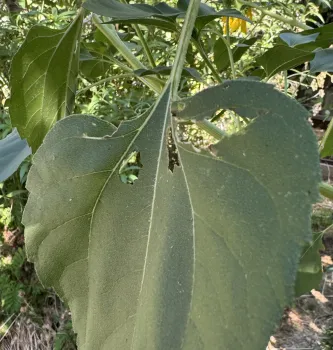Article and photo by Peg Smith -
Our summer has been remarkably kind with its temperatures this year. I think I should whisper this in case summer decides to throw at us those late-season high temperatures and winds that we have experienced before. Continue to avoid overdoing your personal strength and energy supply, work early mornings, stay hydrated, a good book or long put-off ‘inside’ project are ideal for the afternoons.
August is the time to begin our fall planning. As the summer vegetables, zinnias and sunflowers brighten each day, consider any changes you may want to make in the garden. Collect ideas, measure garden areas, design your efforts to complete, a piece at a time, a small component of your grand plan. As each piece is completed, you can have the pleasure and satisfaction of watching it establish and grow as you move to the next project.
Ornamentals and Annuals
Keep up the deadheading and deep watering, and your garden will produce a floral display well into the fall. In our climate, it is no longer unusual to be able to gather roses for the Thanksgiving table. With good maintenance and a fertilizer feed now, the roses will bloom into late fall.
Grouping container pots makes watering easier and provides some humidity around the plants to ease the effects of the drying sun and wind of summer.

Diseases, Pests and Beneficials
You may find sunflower leaves tattered and torn; this damage is from the bird life in the garden. A few tattered leaves are a small price to pay for the quantity of aphids, scale and insects that are consumed by our feathered friends. The damage shown in the photo is from the bird life in the garden. Finches are the most common culprits.
Make sure you provide good water sources for birds and bees. Birds love moving water, if you set up a sprinkler on a hot day you will be able to observe finches, hummingbirds and bushtits cooling off and bathing. Bees prefer shallow water; a simple bee watering station can be made by using a shallow dish with a layer of marbles or stones across the bottom, not completely covered with water. This allows the bees to settle and drink without risk of drowning, as bees cannot swim. Refresh bird and bee watering stations regularly, clean and replenish.
Bulbs
Bulb catalogues are fun to look through to see if you would like to add, perhaps other colors to the garden such as the brilliant blue of Ithuriel’s Spear (Triteleia laxa) a California native, for late spring color, or a variety of alliums that come in many shapes, sizes, and colors for both spring and summer.
Fruits
Fertilize berry canes. Now is the time to prune apricot and cherry trees. Dormant pruning in the winter months is not recommended for cherry and apricot trees as the moisture-borne fungal diseases that affect these trees will enter through injury or pruning sites. Eutypa, a fungal disease in apricots, causes leaf, branch, cankers, limb dieback and eventual tree death.
Clean up any fallen fruit to prevent disease transmission.

August Vegetable Planting Guide
Click the thumbnail image on the right to open a larger image or the link below to open a PDF of Peg's July Vegetable Planting Guide. This guide will tell you which Yolo County and Sacramento area vegetables are recommended for planting during the month of July, along with how and when to plant them.
Thumbnail photo: "Triteleia laxa flower in bloom" by First Light (talk) is licensed under CC BY 3.0.

